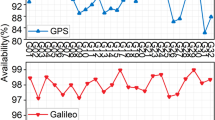Abstract
We propose a new data analysis process that is referred to as the upsampled common-view (UCV) method, which evolved via the interpolation techniques of portable clock trips and digital signal processing. By interpolating the locally measured global positioning system (GPS) P3 code time offsets to obtain global visible common-view (CV)-like results, we increase the number of data points at each epoch; these points are not restricted to the epoch in which the observations occur. The time transfer results between two laboratories are obtained from a weighted average among all the visible GPS satellites. Daily files of GPS observation data were used in the study. We demonstrate the results of three long-baseline links among the Telecommunication Laboratories (TL) in Asia, the Physikalisch-Technische Bundesanstalt (PTB) in Europe and the United States Naval Observatory (USNO) in North America. The rapid UCV results provide time stability at the level of 100 ps at averaging times around 1 d, which is comparable to the P3 all-in-view (AV) results. Comparing the UCV results with precise point positioning (PPP), the root mean square (RMS) of the double differences for the TL-PTB, TL-USNO and USNO-PTB links are 0.29 ns, 0.38 ns and 0.34 ns, respectively, during a period of 40 d. The low RMS values show that the smooth UCV results are close to the PPP results.
















Similar content being viewed by others
Data availability
The daily CGGTTS files of each laboratory are available at the following websites: TL TLT1: ftp://ftp.stdtime.gov.tw/pub/gps/tlt1 PTB PT13: ftp://ftp.ptb.de/pub/time/GNSS/PT13 USNO US06: ftp://5.144.141.242/data/UTC/USNO/links/cggtts, members only (password protected). Results of the PPP from the BIPM are available at TAIPPP: ftp://ftp2.bipm.fr/pub/tai/timelinks/taippp Results of the P3 AV from the BIPM are available at ftp://ftp2.bipm.org/pub/tai/timelinks/lkc/2001/
References
Agnew DC, Larson KM (2007) Finding the repeat times of the GPS constellation. GPS Solutions 11:71–76. https://doi.org/10.1007/s10291-006-0038-4
Allan DW, Thomas C (1994) Technical directives for standardization of GPS time receiver software. Metrologia 31:69–79. https://doi.org/10.1088/0026-1394/31/1/014
Allan DW, Weiss MA (1980) Accurate time and frequency transfer during common-view of a GPS satellite. In: Proceedings of 34th annual frequency control symposium, Philadelphia, Pennsylvania, USA, May 28–30, pp 334–346. https://doi.org/10.1109/FREQ.1980.200424
Crochiere RE, Rabiner LR (1983) Multirate digital signal processing. Prentice-Hall, Englewood Cliffs, pp 35–36
Defraigne P, Petit G (2015) The CGGTTS-Version 2E: extended standard for GNSS time transfer. Metrologia 52(6):G1. https://doi.org/10.1088/0026-1394/52/6/G1
Gotoh T (2005) Improvement GPS time link in Asia with all in view. In: Proceedings of the 2005 IEEE international frequency control symposium, Vancouver, BC, pp 707–711. https://doi.org/10.1109/FREQ.2005.1574021
Harmegnies A, Defraigne P, Petit G (2013) Combining GPS and GLONASS in all in view for time transfer. Metrologia 50(3):277. https://doi.org/10.1088/0026-1394/50/3/277
Imae M (2003) Precise time and frequency transfer. J Natl Inst Inf Commun Technol 50(1/2):105–112
Jiang Z, Petit G (2004) Time transfer with GPS satellites all-in-view. In: Proceedings of ATF2004 (Asia-pacific workshop on Time and Frequency), Beijing, China, pp 236–243
Kouba J, Héroux P (2001) Precise point positioning using IGS orbits and clock products. GPS Solut 5:12–28. https://doi.org/10.1007/PL00012883
Matsakis D, Breakiron L, Bauch A, Piester D, Jiang Z (2009) Two-way satellite time and frequency transfer (TWSTFT) calibration constancy from closure sums. In: Proceedings of the 40th annual precise time and time interval (PTTI) systems and applications meeting, Reston, Virginia, pp 587–604
Nelson RA, Alley CO, Rayner JD, Shih YH, Steggerda C, Wang B, Agnew B (1993) Experimental comparison of time synchronization techniques by means of light signals and clock transport on the rotating earth. In: Proceedings of 24th precise time and time interval meeting, McLean, Virginia, pp 87–104
Petit G, Jiang Z (2004) Report of the TAIP3 experiment. In: Consultative committee for time and frequency (CCTF) Report, CCTF/04–18, pp 1–13
Petit G, Jiang Z (2007) GPS all-in-view time transfer for TAI computation. Metrologia 45(1):34–35. https://doi.org/10.1088/0026-1394/45/1/006
Petit G, Jiang Z (2008) Precise point positioning for TAI computation. Int J Navig Obs 2008:1–8. https://doi.org/10.1155/2008/562878
Savory J, Romisch S, Hernandez L, Maurer K (2017) Local distribution and calibration of timing signals at NIST. In: Proceedings of the 48th annual precise time and time interval systems and applications meeting, pp 326–334. https://doi.org/10.33012/2017.14994
Teunissen P, Montenbruck O (2017) Springer handbook of global navigation satellite systems. Springer, Berlin
Tseng WH, Lin SY (2020) Remote calibration of time scale difference by moving a portable cesium clock. In: Proceedings of the 2020 joint conference of the IEEE international frequency control symposium and international symposium on applications of ferroelectrics (IFCS-ISAF), Keystone, CO, USA, pp 1–3. https://doi.org/10.1109/IFCS-ISAF41089.2020.9234863
Vondrak J (1969) A contribution to the problem of smoothing observational data. Bull Astron Inst Czechoslovakia 20:349–355
Zhang V (2007) Estimating the receiver delay for ionosphere-free code (P3) GPS time transfer. In: Proceedings of the 38th annual precise time and time interval (PTTI) Meeting, Reston, Virginia, pp 467–472
Acknowledgments
We thank the PTB and USNO for their observations. We also thank Dr. Demetrios Matsakis for his helpful comments.
Author information
Authors and Affiliations
Corresponding author
Additional information
Publisher's Note
Springer Nature remains neutral with regard to jurisdictional claims in published maps and institutional affiliations.
Supplementary Information
Below is the link to the electronic supplementary material.
Rights and permissions
About this article
Cite this article
Tseng, WH., Lin, SY. Improving long-baseline rapid GPS time transfers by a modified common-view method. GPS Solut 25, 39 (2021). https://doi.org/10.1007/s10291-021-01088-0
Received:
Accepted:
Published:
DOI: https://doi.org/10.1007/s10291-021-01088-0




